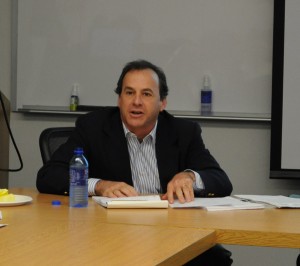Experts look at religious development
USC professor Lisa Bitel and lecturer Lynn Swartz Dodd hosted a seminar Tuesday at the Social Sciences Building that focused on the role of text, magic and tradition in the spread of religions. The event, “Haunted Religion,” featured lectures from Boston University’s David Frankfurter and UCLA’s Jacco Dieleman.

History · David Frankfurter, a professor of religion at Boston University, shared information Tuesday from a chapter of his latest research, which is tentatively titled “Christianizing Egypt: Syncretism and Local Worlds in Late Antiquity,” at an event hosted by the Center for Religion and Civic Culture. – Priyanka Patel | Daily Trojan
Frankfurter, a professor of religion at BU, employed a question and answer format, which focused mainly on a chapter from his latest research, tentatively titled “Christianizing Egypt: Syncretism and Local Worlds in Late Antiquity.” Much of the discussion centered on how shrines help facilitate the combination of indigenous Egyptian religious beliefs and orthodox Christian beliefs. The event was organized by USC’s Center for Religion and Civic Culture’s Interdisciplinary Research Group.
Frankfurter captured the essence of his chapter by reading some of his writing regarding shrines and their purpose as an arena for people to experience divinity.
“Their [the shrines’] importance for the popular conceptualization of Christianity cannot be understated,” Frankfurter said. “For a religion that first spread through legends and claims of miraculous healing and dramatic exorcisms, these buildings became arenas for thaumaturgical display — for people to experience the immanence of some heroic martyr, biblical prophet or holy man.”
Dieleman, an associate professor of Egyptology at UCLA, discussed his paper “From Pharaonic to Greco-Egyptian Magic: The Case of Textual Amulets.”
In his presentation, Dieleman discussed the changing materials used in Egyptian amulet making, particularly the adoption of metal amulets before the turn of the first century.
Dieleman’s presentation also discussed the materials used to make amulets throughout time. Initially, amulets were created out of linen and papyrus. He went on to discuss the move away from these materials to metal, and how the orientation of the amulets changed.
Frankfurter explained that the combination of Christianity and indigenous religions was not unique to Egypt. Using Egypt as an example, however, is beneficial because better historical references exist in Egyptian history than in other cultures that experienced similar conversions to Christianity, he said.
Frankfurter also noted that lessons from Egypt can be applied to these other cultures where there is less documentation of historical events.
“What is peculiar about Egypt is that we have better documentation for the antiquity of certain practices,” Frankfurter said. “We can take that model to other areas of the [Roman Empire] that have less documentation, like Gaul, where very often we rely on Roman historians to tell us what these people were doing before Christianity.”
To this end, Frankfurter noted some features of Egyptian Christianity, particularly how and why indigenous practices contributed to the religion.
“Eygptian Christianity was Eygptian as well as Christian. We have to appreciate the contribution of the indigenous practices to Christianity,” Frankfurter said. “Egypt offers a rich picture of this process.”
Frankfurter said that different objectives led the church and the indigenous Egyptians to participate in the same process of Christianization.
“There is the interest of the church in destroying Satan and spreading religion,” he said. “And then the interest of the communities in wanting to be part of this large movement.”
During the rest of the lecture, Dieleman discussed the possible reasons and the geographical origin of this shift.
“This suggests that the use of metal is Mediterranean and maybe started in Phoenicia and then was taken over by the Greeks, and came into Egypt with Alexandria and was taken up as part of existing Egyptian tradition,” he said.
